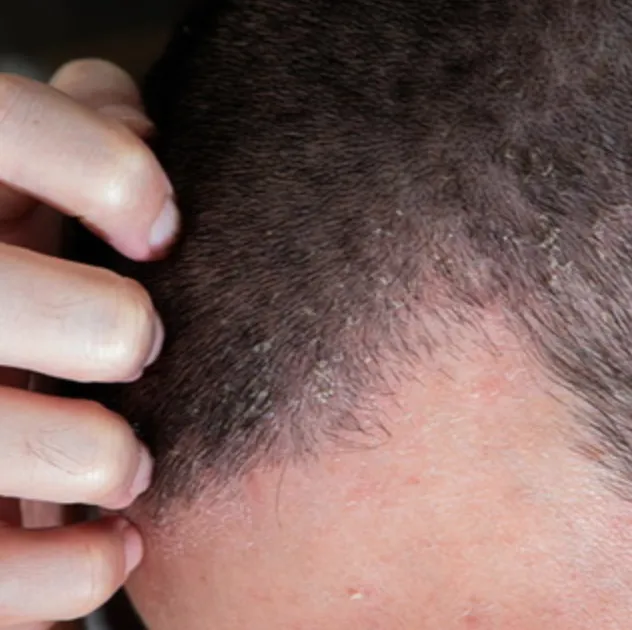St. Pete Location
Bradenton Location
Patient Education
We're passionate about helping people achieve their healthiest, happiest skin. Whether you're struggling with acne, eczema, rosacea, or any other skin concern, we're here to offer support, information, and inspiration.

Seborrheic Dermatitis: Understanding, Treating, and Managing This Common Skin Condition | Leah Michel, APRN, FNP-BC
Seborrheic Dermatitis: Understanding, Treating, and Managing This Common Skin Condition
Seborrheic dermatitis is a common skin condition that mostly affects parts of the body including the scalp, face, and upper chest that have a lot of oil glands. It produces redness, irritation, and peeling.

What is Seborrheic Dermatitis?
Seborrheic dermatitis is a chronic, inflammatory skin condition that primarily affects sebum-rich areas of the body, such as the scalp, face, and trunk (1). It is characterized by red, inflamed skin covered with flaky white or yellowish scales (6). In individuals with darker skin tones, the rash may appear as lighter patches compared to the surrounding skin (3).
This common dermatological issue affects people of all ages, from infants (where it's known as cradle cap) to adults. The severity of seborrheic dermatitis can range from mild dandruff to more severe, widespread inflammation (1). It's important to note that while the condition can be irritating and sometimes embarrassing, it is not contagious (5).
Seborrheic dermatitis often follows a pattern of flare-ups and remissions. Many people experience increased activity during winter and early spring, with improvements typically occurring in summer (1). The condition can significantly impact quality of life, especially when it affects visible areas like the face and scalp.
How to Get Rid of Seborrheic Dermatitis
While there is no permanent cure for seborrheic dermatitis, various treatments and management strategies can help control symptoms and reduce flare-ups:
Medicated Shampoos: Over-the-counter antifungal shampoos containing ingredients like ketoconazole, selenium sulfide, or zinc pyrithione can be effective for scalp seborrheic dermatitis (4).
Topical Treatments: Prescription-strength creams or ointments containing corticosteroids (like hydrocortisone or fluocinolone) or antifungal agents (such as ketoconazole) can help manage symptoms on the face and body (4).
Lifestyle Changes: Reducing stress, maintaining a healthy diet, and avoiding harsh skincare products can help minimize flare-ups (5).
Regular Cleansing: Gently washing affected areas with a mild, non-irritating cleanser can help remove excess oil and scale buildup (4).
Light Therapy: In some cases, ultraviolet B (UVB) light therapy may be recommended by a dermatologist to manage stubborn symptoms (4).
It's crucial to work with a healthcare provider to develop a personalized treatment plan, as the effectiveness of treatments can vary among individuals.
What are Potential Causes?
The exact cause of seborrheic dermatitis remains unclear, but research suggests it results from a combination of factors:
Malassezia Yeast: Overgrowth of this naturally occurring skin fungus is strongly associated with seborrheic dermatitis (2). While Malassezia is present on everyone's skin, those with seborrheic dermatitis may have an abnormal immune response to it (1).
Sebum Production: Increased activity of sebaceous glands, leading to excess oil production, creates an environment where Malassezia can thrive (2).
Immune System Factors: Alterations in immune function may play a role, as evidenced by the higher prevalence of seborrheic dermatitis in immunocompromised individuals (2).
Genetic Predisposition: There appears to be a genetic component, as seborrheic dermatitis tends to run in families (5).
Neurological Conditions: Certain neurological diseases, including Parkinson's disease and Alzheimer's, are associated with an increased risk of seborrheic dermatitis (7).
Hormonal Influences: Androgens and adrenal corticosteroids may stimulate sebaceous gland activity, potentially contributing to the condition (7).
Environmental Factors: Changes in climate, particularly cold and dry weather, can trigger or exacerbate symptoms (5).
Recent research has also explored the potential role of nutrition and obesity in seborrheic dermatitis. A 2024 systematic review suggested that dietary factors and body mass index (BMI) might influence the clinical course of the condition, similar to their impact on other inflammatory skin diseases (7).

What are Conditions Similar to Seborrheic Dermatitis?
Several skin conditions can present similarly to seborrheic dermatitis, making accurate diagnosis crucial:
Psoriasis: This chronic autoimmune condition can be challenging to distinguish from seborrheic dermatitis, especially on the scalp. However, psoriasis typically has thicker, more well-defined plaques with silvery scales.
Atopic Dermatitis (Eczema): While both conditions cause red, itchy skin, atopic dermatitis usually affects different body areas and is less likely to have greasy scales (3).
Contact Dermatitis: This skin reaction to irritants or allergens can look similar but is usually confined to areas of direct contact with the triggering substance.
Rosacea: When seborrheic dermatitis affects the face, it may be mistaken for rosacea. However, rosacea typically causes persistent redness and visible blood vessels without the scaling seen in seborrheic dermatitis (6).
Tinea Versicolor: This fungal infection can cause discolored patches on the skin but lacks the inflammation and scaling characteristic of seborrheic dermatitis.
Understanding these distinctions is essential for proper diagnosis and treatment. If you're unsure about your skin condition, it's best to consult a dermatologist for a professional evaluation.
Seborrheic Dermatitis Treatment
Treatment for seborrheic dermatitis aims to manage symptoms, reduce inflammation, and control the overgrowth of Malassezia yeast. The approach often involves a combination of the following:
Topical Antifungals: Medications like ketoconazole, ciclopirox, or selenium sulfide target the Malassezia yeast. A 2024 study published in the Journal of Clinical Medicine found that a combination of ketoconazole and betamethasone dipropionate was highly effective in treating facial seborrheic dermatitis (Gkalpakiotis et al., 2024).
Topical Corticosteroids: Low to mid-potency corticosteroids like hydrocortisone or desonide can quickly reduce inflammation and itching. However, long-term use should be monitored due to potential side effects.
Calcineurin Inhibitors: Topical tacrolimus and pimecrolimus are steroid-free alternatives that can be particularly useful for facial seborrheic dermatitis.
Medicated Shampoos: For scalp involvement, shampoos containing zinc pyrithione, selenium sulfide, or ketoconazole are often recommended (4).
Phototherapy: In resistant cases, controlled exposure to UVB light under medical supervision may be beneficia (4).
Systemic Treatments: In severe or widespread cases, oral antifungal medications like itraconazole might be prescribed. A 2023 systematic review in the Journal of Clinical Medicine highlighted the potential of oral itraconazole as an effective treatment for severe seborrheic dermatitis (Gkalpakiotis et al., 2023).
Natural Remedies: Some patients find relief with natural treatments like tea tree oil or aloe vera, although scientific evidence for their efficacy is limited (4).
Dietary Interventions: While more research is needed, some studies suggest that dietary modifications, particularly reducing sugar and processed foods, may help manage symptoms (Sanders et al., 2021).
It's important to note that treatment often needs to be ongoing, as seborrheic dermatitis tends to recur when treatment is stopped. A dermatologist can help develop a long-term management plan tailored to individual needs and severity.
Seborrheic Dermatitis Treatment at My Skin St Pete
My Skin St Pete, located in downtown St. Petersburg, Florida, offers comprehensive dermatological care for various skin conditions, including seborrheic dermatitis. For seborrheic dermatitis treatment, My Skin St Pete likely offers several options commonly used by dermatologists:
Medicated shampoos containing antifungal agents like ketoconazole, selenium sulfide, or pyrithione zinc.
Topical corticosteroids to reduce inflammation and itching.
Topical antifungal creams or solutions.
Calcineurin inhibitors like tacrolimus or pimecrolimus for facial seborrheic dermatitis.
Personalized treatment plans based on the severity and location of the condition.
My Skin St Pete emphasizes patient-centered care, taking time to listen to concerns and develop individualized treatment strategies. They offer both medical and cosmetic dermatology services, ensuring comprehensive skin care for their patients.
Schedule an appointment now for seborrheic dermatitis treatment at My Skin St Pete.
Conclusion
Seborrheic dermatitis is a complex, chronic skin condition that affects millions worldwide. While its exact causes remain elusive, our understanding of its pathophysiology and treatment options continues to evolve. Recent research has shed light on the intricate interplay between Malassezia yeast, immune function, and environmental factors in the development and persistence of this condition.
Managing seborrheic dermatitis often requires a multifaceted approach, combining topical treatments, lifestyle modifications, and sometimes systemic therapies. As research progresses, we may see more targeted and effective treatments emerge. For now, working closely with a dermatologist and maintaining a consistent skincare routine are key to keeping symptoms under control and improving quality of life for those affected by seborrheic dermatitis.
Remember, while seborrheic dermatitis can be frustrating to deal with, it is a manageable condition. With proper care and treatment, most people can achieve significant improvement in their symptoms and maintain healthy, comfortable skin.
References:
Handler, M. Z., MD. (n.d.). Seborrheic Dermatitis: practice essentials, background, pathophysiology.
Hewett, L. (2023, March 6). Seborrheic Dermatitis — What the Latest Research is Saying, From How it Develops to Current Treatments and More. National Eczema Association.
Tabackman, L. (2024, November 29). What to know about seborrheic dermatitis. Healthline.
Smith, J. (2023, November 15). Seborrheic dermatitis: Symptoms, causes, and treatment. Healthline.
National Eczema Association. (2025, February 25). Seborrheic dermatitis: Causes, symptoms, treatment | National Eczema Association.
Seborrheic dermatitis - Symptoms and causes. (n.d.). Mayo Clinic.
Conditions that can look like psoriasis but aren’t. (n.d.). WebMD. https://www.webmd.com/skin-problems-and-treatments/psoriasis/conditions-like-psoriasis-but-arent
Disclaimer:
The information on this website is provided for educational and information purposes only and is not medical advice. Always consult with a licensed medical provider and follow their recommendations regardless of what you read on this website. If you think you are having a medical emergency, dial 911 or go to the nearest emergency room. Links to other third-party websites are provided for your convenience only. If you decide to access any of the third-party websites, you do so entirely at your own risk and subject to the terms of use for those websites. Neither My Skin by Leah Michel, APRN, FNP-BC, nor any contributor to this website, makes any representation, express or implied, regarding the information provided on this website or any information you may access on a third-party website using a link. Use of this website does not establish a doctor-patient relationship. If you would like to request an appointment with a health care provider, please call our office at (727) 295-7223.
If you have any questions or concerns about your skin & would like to schedule an appointment at our St. Pete dermatology office or Brandenton dermatology office, please call us today!
St. Pete Location
111 2nd Ave NE., Suite 1406
St Petersburg, FL 33701
Plaza Tower- Downtown St Pete
Phone: (727) 295-7223
Bradenton Location
4301 32nd St. W., Suite D2
Bradenton, FL 34277
Phone: (941) 330-5805







